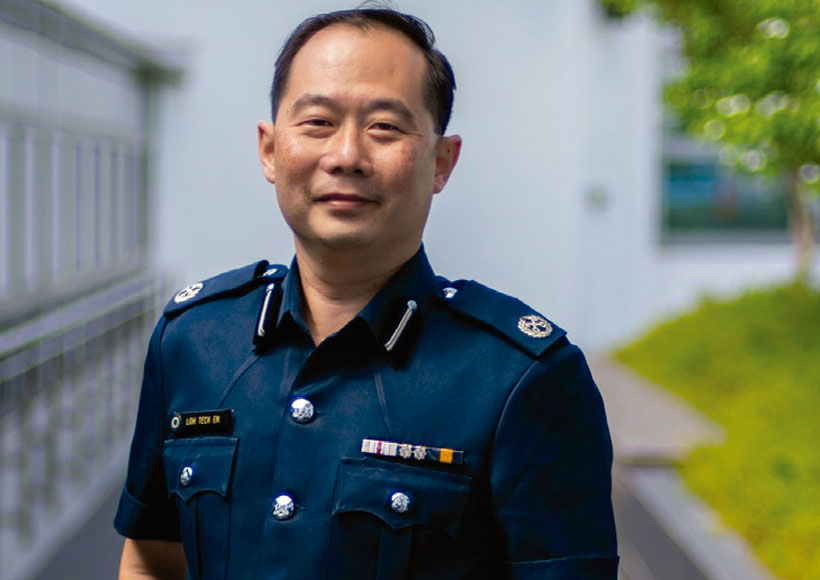// Short interview: Loh Teck En
Director of the Transformation and Technology Division, Singapore Prison Service
JT: What underlies the increasing adoption of technologies by the Singapore Prison Service (SPS)?
LTE: Like all other government agencies in Singapore, the Singapore Prison Service will face an unprecedented age shift due to our declining birth rates. By 2030, more than a quarter of Singapore’s citizen population will enter their silver years – 60 years of age and above.
A shrinking workforce would mean that we must work towards transforming Singapore’s correctional landscape by 2025. Therefore, we embarked on the journey to transform our operation based on the concept of Transformed Housing Unit.
In this new concept, we will utilise technologies such as mobile devices for officers and self-service platforms for offenders which improve the effectiveness and efficiency of our operation. Technology is, therefore, an enabler for our officers to have more purposeful engagement with offenders and work on their rehabilitative needs, which will bring about effective rehabilitation outcomes for SPS.
JT: What technologies have been/will be deployed in the SPS?
LTE: One of the initiatives that enables our officers to gain greater ground situational awareness is the implementation of mobile devices for PORTS (Prison Operations and Rehabilitation Systems) in April 2017, which is the upgraded version (II) of our offender management system that supports our officers’ daily operations, inmate administration, and rehabilitation.
The device comes with a vendor-developed app version of PORTS II, which allow our officers to readily access and capture inmates’ data when they are working in the prison facilities and away from their workstations. The system also includes capabilities such as a Business Intelligence dashboard which provides our officers with one-stop access to information. From the dashboard, officers-in-charge can generate statistics and reports to facilitate trends’ analysis and insights. With improved situational awareness, our officers can respond more promptly and effectively in their management of operations/incidents.
Another initiative is the implementation of DIRECT (Digitalisation of Inmate Rehabilitation and Corrections Tool) which is a suite of in-house developed applications that are deployed on shared tablets to better manage inmates and their activities, to aid in prisons’ daily operations. These applications include e-Books, e-News, e-Letters and e-Learning. Through DIRECT, inmates can carry out a wide range of processes (e.g. sending and receiving e-letters) and rehabilitation materials via digital self-service.
For example, applications such as e-Books and e-News replace inmates’ hardcopy reading materials. With these, security is enhanced as the risk of smuggling contrabands into prison is reduced. The e-Learning feature made available through DIRECT complements our rehabilitation efforts by enabling inmates to access self-learning educational materials, such as Workforce Skills Qualifications and literacy programmes.
To aid inmates’ reintegration back to their family upon release, e-Letters in DIRECT also promote more and faster correspondences between inmates and their families. With services made available to inmates through the self-serve digital platform, the implementation of DIRECT frees up our officers from processing such services for offenders. We are currently in the midst of developing more new applications, such as e-Forms, through vendors, for full implementation this year.
JT: What are the main challenges you encountered in the process of introducing technology within the Singapore Prison Service?
LTE: The main challenge we encountered in the process of introducing technology within SPS is managing change. New technology changes processes, policies and to some extent the competencies required in our officers. These changes impact the operations in all the twelve SPS’s prison institutions. We had to manage the changes well in order not to affect, or even impede, the prisons’ operations when implementing the technology.
To address the challenge, we take the approach of piloting the technology in selected prisons before phasing the implementation to all other prisons. This approach gives us the opportunity to test out new policies and iron out teething issues in both technology and processes, before the actual implementation. The roll-out to prison institutions is also done in a phased approach.
JT: To what extent and in what ways do the technologies that are implemented or being tested by the SPS anticipate the convergence between Information Technology (e.g. offender management system, HR system, Medical Record Systems, etc) and Operational Technology (e.g. CCTV, HVAC, RFID badges, door control, perimeter detection, etc.)?
LTE: Since 2004, the Changi Prison Complex had introduced the Integrated Security System (ISS) which integrates information from our offender management system to support the prisons’ Control Centres in accessing controls and operations of other systems such as CCTV and the intercom systems. For example, when an inmate uses the intercom system within the prison cell to speak to our officers at the Control Centre, our officers are able to establish the identity of the speaker based on the information from the offender management system.
Moving ahead, to achieve the transformed operational concept of Transformed Housing Unit, information technology and operational technology have to achieve synergy and integration to support our Ground Commanders in their management of the prisons. We are developing an enterprise-level ISS which will ease the introduction of new systems or capabilities into Prisons’ Control Centres.
For example, we are trialling the use of facial recognition technology to supplement the physical headcount checks of inmates. Cameras in the cells will capture the facial images of inmates during the headcount check and verify these features with the ones recorded in the offender management system. Discrepancies will be highlighted to the officer manning the Control Centre for further verification. When successful, this capability will be introduced through the enterprise ISS for implementation across our prisons.
JT: How important is the collaboration between different departments of the SPS and what impact does the degree of this collaboration have on the role that technology plays in the system?
LTE: Collaboration is paramount to the success of implementing new technology in SPS. Policies have to be clear and must not conflict with other existing policies. Processes have to be agreed on by all affected stakeholders. Different divisions and line units have to also consider the new technology in their planning for new initiatives. Any misalignment to the policies, processes or planning of other initiatives would adversely impact the implementation of new technology into prisons.
When implementing new technology in SPS, we have several platforms that can allow us to discuss the proposed changes to policies and processes with other divisions and line units before finally communicating the changes to our officers during implementation.
JT: What prognosis do you make for the digital evolution of the SPS in the medium term?
LTE: With much effort spent on transforming our prison operations, we are moving ahead to digitalise all our administrative processes and go paperless by the year 2023. In the medium term, SPS will leverage heavily on digital platforms and automation to digitalise these services. With data available, data analytics will be able to serve us with insights to trends and gaps in our processes for continuous improvement.
//
Deputy Assistant Commissioner Loh Teck En joined the Singapore Prison Service in 1996 and had been rotated to perform various job functions ever since. His previous leading positions include being the Commander of a Cluster of prison institutions. He also held several key staff positions related to corporate services, including Head of Prison Logistics Branch. Currently, he is the Director of Transformation and Technology. His portfolio entails the formulation and implementation of the SPS’ transformation plan through the use of technology.


